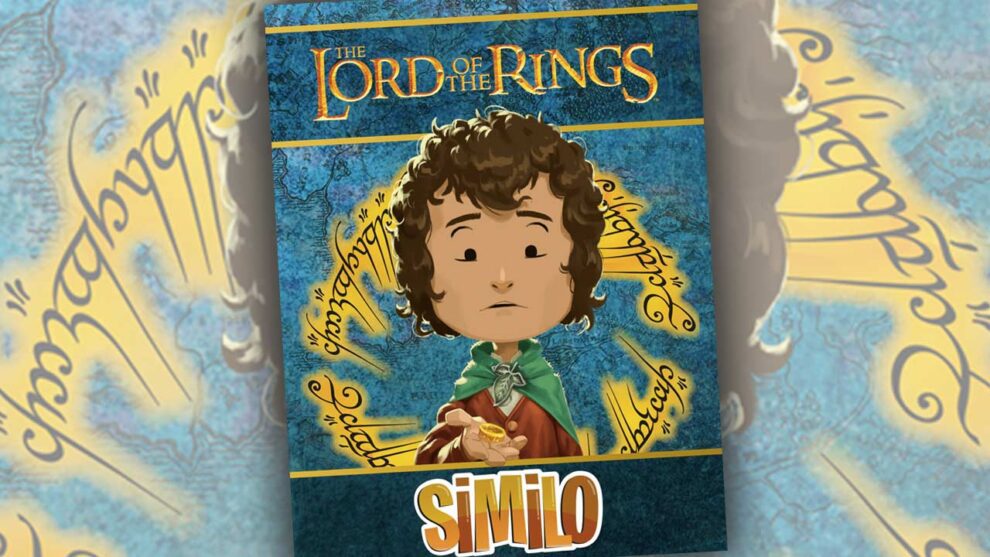Similo, from design team Martino Chiacchiera, Hialmar Hach, and Pierluca Zizzi, in collaboration with publisher Horrible Guild, is a cooperative deduction game. Players take turns as the clue giver, who starts each round by drawing a single card from the deck. That card is then shuffled with eleven other cards, which are all dealt out face-up into a 3×4 grid.
The clue giver draws five cards from the deck and plays one out on the table. The card is placed either vertically, to indicate that this card and the target card share something in common, or horizontally, to indicate that they are unalike in some way. After the first clue, the rest of the players agree on a single card to remove. After the second clue, they must remove two. After the third, three, and after the fourth, well, you probably get it. The fifth and final clue has to steer the players between one of the two remaining cards. If the last card remaining is the target card, everyone wins!
I’ll note here that while the clue giver does draw a new card to replace each clue, we discovered a fun—and profusely sweaty—variant in which the clue giver is limited to the five cards they drew at the beginning of the game. They have to figure out the best order in which to play the clues to try and get the right result.

Variety Is the Spice of Similo
The beauty of a system like Similo is the room for variety. Decks include Animals, the slightly spicier Wild Animals, Fables, Myths, History, and more. The last several years, Horrible Guild has even published a promotional deck for Essen Spiel that includes board games making their debut at the convention.
Inevitably, there are licensed decks. I say “inevitably” not as a complaint about the quality—this doesn’t feel like some sort of fundamental betrayal of Similo’s integrity—but as an acknowledgement of the world we live in. Of course there are licensed decks. First, there was Similo: Harry Potter, and now, Similo: The Lord of the Rings.
“We Can Only Safely Remove Gothmog”
We cracked open Similo: The Lord of the Rings after a few rounds of Similo: Wild Animals. I was impressed by the contrast. The subtlety that familiarity with the subject matter brings to Similo is considerable.
Consider our first game. Our grid of twelve cards looked like this:

My friend Elizabeth, no LotR slouch, was giving the clues. By playing, in order, Isildur vertically, Treebeard horizontally, Mouth of Sauron vertically, Merry horizontally, and Gríma Wormtongue vertically, we managed to find the correct answer. Can you figure it out?
After Isildur, we tossed Gothmog. Of all the characters on the table, he was arguably furthest from the Ring and the dark powers that birthed it. Treebeard told us that it wasn’t King of the Dead or Balrog. Mouth of Sauron was next, and with him went Shelob, Galadriel, and Éowyn. Merry told us all we needed to know about Rosie Cotton, who’d been on the outs for a round or two, Frodo, Gollum—he used to be a Hobbit (yes, yes, I know)—and Faramir.
This left us with a tough final pairing of Sauron and the Nazgûl. Elizabeth’s final clue, a vertical Gríma Wormtongue, caused much disagreement.
“It’s Sauron,” Robin said.
“Iiiiii’m not sure,” I replied.
“Mouth of Sauron points pretty heavily to Sauron, if you ask me.”
“Yes, but all three of these vertical clues are human men who were corrupted by Sauron’s power. That’s the Nazgûl,” Laura countered.
“Yeah, that’s what I was thinking,” I said.
Robin deferred to the majority, and it’s a good thing. It was, in fact, the Nazgûl.
I have repeated this sequence of clues with a few different Lord of the Rings fans, and they’ve all gotten it right, taking a remarkably similar route to get there.
I Dream of Playing Éowen Horizontally as the Final Clue for the Witch-king of Angmar
I enjoy Similo quite a bit. Is it deep? Well, no, but I also don’t think depth is what we’re looking for here. This is about having a silly, fun time with your friends, and Similo manages that beautifully. I enjoy most cooperative clue-giving games where the clue can backfire, and Similo is ideal for something to play while enjoying a relaxed evening at the table.
I do think there’s surprising depth—“subtlety” really may be the best word—once you incorporate cards that suggest narratives. I’ll need to give more decks a try to confirm this—I’ve already ordered Myths, Fables, and History since completing this review—but my early experiences indicate that I like Similo a whole lot more when the cards have nuanced connections. Playing Similo with animals is a great way to play with kids. It’s a bit flat with adults. Similo: The Lord of the Rings will appeal to a narrower audience, by necessity, but if that audience is the right one, you can communicate a whole lot with just five cards.











Sounds like a good time was had by all. This is not my cup’o’tea, but it does sound like it would be fun for the right group of people.
🙂